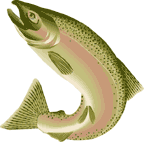
Just two weeks ago the spring run was so weak that officials worried it could represent one of the smallest runs on record. Now, the spring run appears so robust that it’s exceeding even the original (pre-worry) estimates. The run is strong enough that commercial fishing is starting up again today and a sport season will begin later this week. At last count, more than 76,000 Chinook had made it past the Bonneville Dam, more than in all of 2005 and with two weeks still remaining in the spring run. And biologists think the season will bring roughly 100,000 Chinook in total.
The changing Chinook run is a reminder of how complex and variable nature is. Compared to some other natural systems, the Columbia salmon are relatively well-understood; and yet despite all of our sizeable investments in technology and study, the runs are very tough to predict.
Climate change may make natural systems even harder to understand. As a warming climate alters streamflows, ocean temperatures, and the timing of available food sources, salmon may respond in hard-to-predict ways. Spring samon may, for instance, return later in the year, making comparisons with past decades even tougher.







